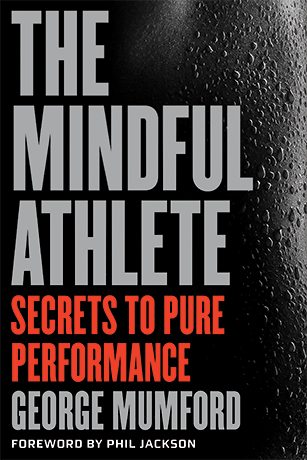The Five Spiritual Superpowers
George Mumford offers his personal spin on the Buddha’s Eightfold Path.
By George MumfordSeventy-two million people were watching game six of the 1998 NBA Championship Finals between the Chicago Bulls and the Utah Jazz. With only eighteen seconds left in the game and the Jazz ahead by one point, an invisible shift seemed to occur: Michael Jordan stripped the ball from Karl Malone, slipped away from Bryon Russell so deftly that Russell careened to the floor, and effortlessly made the winning shot with only five seconds to spare, bringing the Bulls to their sixth championship and second three-peat. It would be Michael Jordan’s and Phil Jackson’s last game with the Bulls, and it is considered one of the greatest plays in NBA sports history. Fans remember what they were doing at that moment the way some people remember where they were when JFK was shot or Neil Armstrong landed on the moon. If you’re too young to remember those milestones, fill in the blanks as you see fit.
I was sitting a few rows behind the bench, watching this groundbreaking play unfold, knowing that Michael was in that very special place called the Zone. “When I got that rebound, my thoughts were very positive,” Michael recounted later. “The crowd gets quiet, and the moment starts to become the moment for me. That’s what we’ve been trying to do… that’s part of that Zen Buddhism stuff. Once you get into the moment, you know when you are there. Things start to move slowly, you start to see the court very well. You start reading what the defense is trying to do. I saw that moment. When I saw that moment and the opportunity to take advantage of it… I never doubted myself. I never doubted the whole game. We were hanging too close.”
I’d been doing “that Zen Buddhism stuff” with the Bulls for five years when Michael Jordan made that famous play, and I had seen countless athletes experience the Zone. By that time, I’d also taught mindfulness to people in every walk of life, from the locker room to the boardroom, from Yale to jail.
Back in the day when I embarked on the journey that would lead me here, people didn’t use the word “mindfulness.” It was called stress management, of which I had plenty—stress, that is. And it was during a moment of extreme stress—crisis, really—that Phil Jackson contacted me in 1993. The Bulls had just come out of that three-peat when the team fell into a crisis: Jordan had announced his retirement in the wake of his father’s murder. Media attention on Jordan, intense under normal circumstances, had reached an almost frenzied state. Meanwhile, the team’s identity was adrift; it had been so wrapped up in Jordan that they were referred to as the Jordan Airs. Without their superstar, public perception of the Bulls’ ability to keep their stride hit an all-time low; team morale went south for the ride. In the midst of this adversity, with team members in various states of emotional distress, Phil had to rebuild a team and bring harmony to discord. That’s when he reached out and brought me to his training camp to teach mindfulness and help heal the team.
 At the time, I was a full-time staff member at the Center for Mindfulness (formerly called the Stress Reduction and Relaxation Program) in Shrewsbury, Massachusetts, and I was teaching mindfulness to prison inmates in a program I helped develop with Jon Kabat-Zinn in the early nineties. Over the course of five years we’d taught mindfulness to over five thousand inmates in five different locations. I had never been incarcerated, but in addition to being familiar with the stress experienced by professional athletes, I could understand the stress experienced by some of these inmates because, like many of them, I grew up in the inner city where impulse control is, shall we say, something of a problem.
At the time, I was a full-time staff member at the Center for Mindfulness (formerly called the Stress Reduction and Relaxation Program) in Shrewsbury, Massachusetts, and I was teaching mindfulness to prison inmates in a program I helped develop with Jon Kabat-Zinn in the early nineties. Over the course of five years we’d taught mindfulness to over five thousand inmates in five different locations. I had never been incarcerated, but in addition to being familiar with the stress experienced by professional athletes, I could understand the stress experienced by some of these inmates because, like many of them, I grew up in the inner city where impulse control is, shall we say, something of a problem.
When Michelangelo was asked how he created his masterpieces, he replied that all he did was to chip away to get to the masterpiece that was already inside. I believe we’re all chipping away to get to that masterpiece, even those of us who grew up in the ghetto, on the wrong side of the tracks. We all have a divine spark within us, but we’ve either crushed it, created an ingenious system for hiding out, or devised ways of being that make us feel separate. I now regard each person I meet as a caterpillar in a chrysalis. In order to become butterflies, we have to break our way into freedom and transformation. Mindfulness is a tool we can use to do this in the most skillful way. Admittedly, I had to hit rock bottom with my ass on fire before I figured out the most skillful way out of my own chrysalis.
Mindfulness was the skillful means to help me emerge, and I have used mindfulness techniques to help athletes of every shape, size, age, gender, and skill level emerge to be their own selves. Mindfulness comes out of Buddhist meditation, an ancient practice with many layers of complexity. What I offer here is a synthesis of mindfulness principles that fall under the aegis of what I call the Five Spiritual Superpowers. These Superpowers are my personal spin on the Buddha’s Eightfold Path and on his teaching of the Five Spiritual Faculties: faith, diligence, mindfulness, concentration, and insight. The Eightfold Path was the Buddha’s understanding of the way out of suffering. In his book Old Path White Clouds, the Zen teacher Thich Nhat Hanh tells the story of the way the Buddha regarded the Eightfold Path and all his teachings. According to the story, the Buddha said, “My teaching is not a dogma or a doctrine.” He goes on, “I must state clearly that my teaching is a method to experience reality and is not reality itself, just as a finger pointing at the moon is not the moon itself.”
Consider these Superpowers to be like spokes in a wheel: They are nonlinear and they work together. Take one away, and the wheel doesn’t turn. Remove the hub or the center, and you have no wheel.
The Five Spiritual Superpowers
The Five Spiritual Superpowers are mindfulness, concentration, insight, right effort, and trust. These spiritual superpowers are interconnected and they work together. Buddhism sometimes calls the first three powers—mindfulness, concentration, and insight—the threefold training. Our unconscious mind contains the seeds of all these energies. You can cultivate these three energies throughout the day, in whatever activity you’re engaged. Mindfulness, concentration, and insight contain each other. If you’re very mindful, then you have concentration and insight in your mindfulness. Generating these energies is the heart of meditation practice. They help you live every moment of life deeply. They bring you joy and happiness and help you to handle your own suffering and the suffering in the people around you.
The fourth power, right effort or diligence, is the energy that makes us steadfast in our practice. Cognitive function improves when we have a positive state of mind. Bringing diligence to our practice of mindfulness is a great way to cultivate positive mind-states. But when we practice sitting or walking meditation in a way that causes our body or mind to suffer, that isn’t right effort because our effort isn’t based on our understanding.
The last of the Five Spiritual Superpowers is trust. It can also be seen as faith or confidence, but the way that I like to look at it is as courage. Having the courage to delve into the unknown and trust what is found there makes the practice of mindfulness and the other powers possible.
As my friend Sharon Salzberg puts it in her book Lovingkindness, “Completeness and unity constitute our most fundamental nature as living beings. That is true for all of us. No matter how wonderful or terrible our lives have been, no matter how many traumas and scars we may carry from the past, no matter what we have gone through or what we are suffering now, our intrinsic wholeness is always present, and we can recognize it.”
Being a mindful athlete involves living this truth for yourself, because there is no separating who you are on the court, field, or yoga mat from who you are in the world at large. That “intrinsic wholeness” serves you wherever you are and in whatever you’re doing. Everything is connected.
George Mumford has consulted on each of the NBA championship teams Phil Jackson coached. He’s also consulted with high school, college, and Olympic athletes, inmates, and corporate executives, and he is a sought-after public speaker at both business and athletic conferences, nationally and internationally. He is leading an upcoming retreat at the Garrison Institute with Sharon Salzberg, “Being Mindful: Enriching Your Everyday Life,” on November 17-19.
Excerpted from The Mindful Athlete by George Mumford © 2015. Excerpted with permission of Parallax Press.
